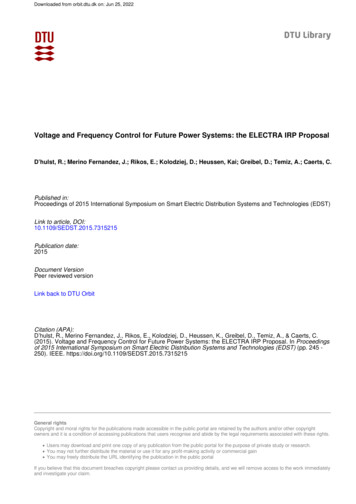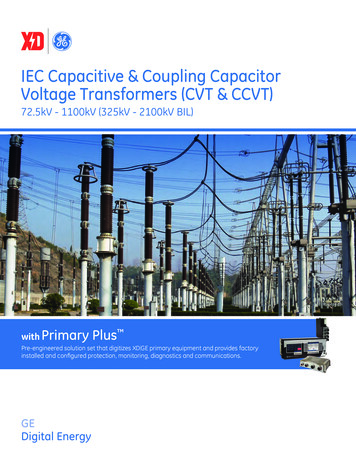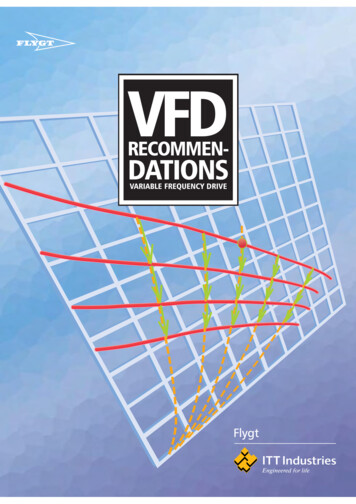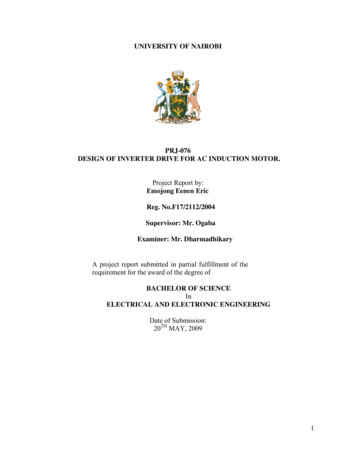
Transcription
Downloaded from orbit.dtu.dk on: Jun 25, 2022Voltage and Frequency Control for Future Power Systems: the ELECTRA IRP ProposalD’hulst, R.; Merino Fernandez, J.; Rikos, E.; Kolodziej, D.; Heussen, Kai; Greibel, D.; Temiz, A.; Caerts, C.Published in:Proceedings of 2015 International Symposium on Smart Electric Distribution Systems and Technologies (EDST)Link to article, DOI:10.1109/SEDST.2015.7315215Publication date:2015Document VersionPeer reviewed versionLink back to DTU OrbitCitation (APA):D’hulst, R., Merino Fernandez, J., Rikos, E., Kolodziej, D., Heussen, K., Greibel, D., Temiz, A., & Caerts, C.(2015). Voltage and Frequency Control for Future Power Systems: the ELECTRA IRP Proposal. In Proceedingsof 2015 International Symposium on Smart Electric Distribution Systems and Technologies (EDST) (pp. 245 250). IEEE. https://doi.org/10.1109/SEDST.2015.7315215General rightsCopyright and moral rights for the publications made accessible in the public portal are retained by the authors and/or other copyrightowners and it is a condition of accessing publications that users recognise and abide by the legal requirements associated with these rights. Users may download and print one copy of any publication from the public portal for the purpose of private study or research. You may not further distribute the material or use it for any profit-making activity or commercial gain You may freely distribute the URL identifying the publication in the public portalIf you believe that this document breaches copyright please contact us providing details, and we will remove access to the work immediatelyand investigate your claim.
Voltage and Frequency Control for Future PowerSystems: the ELECTRA IRP ProposalR. D’hulst , J. Merino Fernández† , E. Rikos‡ , D. Kolodziej§ , K. Heussen¶ , D. Geibelk , A. Temiz , and C. Caerts VITO,Unit Energy Technology, Boeretang 200, 2400 Mol, BelgiumEmail: reinhilde.dhulst@vito.be† Tecnalia, Parque Cientı́fico y Tecnológico de Bizkaia. C/Geldo, Edif. 700, Derio (Bizkaia), Spain‡ CRES, 19th km Marathonos Ave, 19009, Pikermi Attiki, Greece§ IEN, Institute of Power Engineering, Gdansk Division, Mikolaja Reja 27,80-870 Gdansk, Poland¶ DTU, Center for Electric Power and Energy (CEE), Richard Petersens Plads 322, 2800 Kgs. Lyngby, Denmarkk Fraunhofer IWES, Division Systems Engineering and Distribution Grids, Koenigstor 59, D-34119 Kassel, Germany TUBITAK, MRC Energy Institute, METU Campus Ankara, TurkeyAbstract—In this paper a high level functional architecturefor frequency and voltage control for the future (2030 ) powersystem is presented. The proposal suggests a decompositionof the present organization of power system operation into a”web of cells”. Each cell in this web is managed by a singlesystem operator who assumes responsibility for real-time balanceand voltage control of the cell, minimizing the dependencyon inter-cell communication for secure system operation. Theweb-of-cells architecture ensures overall system stability by acombination of decentralized and distributed control patterns forfrequency and voltage control. In each control cell, the operatormaintains an accurate view on the overall cell state, based onadequate monitoring capabilities, and ensures secure operationby allocating and dispatching reserves located in the cell. Intercell coordination provides for efficient system-wide managementand economic optimization.I. I NTRODUCTIONAn inceasingly renewables-based and distributed energysystem as expected in Europe for the time beyond 2030requires a revision of the power system operation principlesso that approapriate level of system security and resilience canbe maintained. he ELECTRA Integrated Research Programme(IRP) [1] has been set-up by the European Energy ResearchAlliance (EERA) partners in the joint programme Smart Gridsto research radical new control solutions for voltage andfrequency control in the 2030 power system.In this paper a high level functional architecture for frequency and voltage control for the future (2030 ) power system is proposed. Based on a number of scenario assumptionsregarding the 2030 power system, a new control architecture to better address the fundamental changes of the futurepower system is presented. This work focuses on the highlevel functional control architecture related to the real-timereserves activation currently performed by transmission systemoperators (TSOs). Moreover, this work covers the correctionof real-time imbalances -hence frequency deviations-, as wellas the regulation of the grid voltage.It is expected that due to the expected changes, furtherelaborated in Section II, the future frequency and voltagecontrol can no longer be effectively managed in a TSO-centricmanner exclusively. Instead, a new approach is proposed,that leverages innovative monitoring systems based on a fullyinstrumented network, and dynamic autonomous distributedcontrol functions especially including distribution networks.The focus of this work is on the development of newfrequency and voltage control schemes applicable to the functional architecture developed within ELECTRA IRP. Reservesmust be contracted through a market party taking into account(regulatory) requirements related to amounts, types, characteristics, location, but this procurement itself is considered outof scope for this work.II. K EY T RENDS AND C ONSEQUENCESAccording to the European Commission Energy Roadmap2050 for long-term plans [2], by the year 2030, around 25% ofthe primary energy will come from RES and the percentagewill increase until up to 60% by 2050. In this context, theELECTRA consortium has indentified seven key trends andassumptions for future power grids:1) Generation will shift from classical dispatchable unitsto intermittent renewablesBased on various reports, it is expected that by 2030,between 52% to 89% of electricity production willstem from RES [3], [4]. As a consequence, there is aparadigm shift needed from generation following loadto load following generation. Also, an increased needarises for balancing reserves activations to correct inreal-time the residual imbalances caused by forecasterrors and variability of intermittent generation andloads. Even though on a global level these errorsmay partially cancel each other out, they may causeimbalances resulting in insecure power flows that mayeventually cause system instability.2) Generation will shift from central Transmission Systemconnected generation to decentralized DistributionSystem connected generation
The production share of RES connected to distributiongrids will increase. As a consequence risk of localvoltage problems and congestions have to be handled.Also, the location of the sources of voltage issues andbalancing problems that require reserves activation,will shift from central transmission system level todistribution system level. Additionally, the resources thatcan help to address voltage and balancing problems,i.e. resources that can provide ancillary servicessupport, will partly move from transmission systemlevel to distribution system level. Therefore a centralsystem operator requires information from operators ofunderlying voltage levels in order to dispatch efficiently.Finally, the distribution and availability of resourcesmay vary significantly from location to location.3) Generation will shift from few large units to manysmaller unitsElectricity production units connected to the distributiongrid are typically much smaller than large centralpower plants. Moreover, a transition is going onwithin electricity production investments from an”OPEX”-driven model towards a model that is more”CAPEX”-driven, leading to more investments insmaller production units as opposed to larger (classic)production plants [5]. As a consequence, there will bemore places, and chances, where incidents (such asgeneration outages) can happen, but each individualincidents will have a smaller, local impact. Sincethe production portfolio within the overall powersystem will be subjected to changes throughout theday (e.g. renewable generators are weather dependent),the electromechanical time constant of the powersystem will depend on the time of the day. Also, thereplacement of large synchronous generation and loadsby converter coupled generation and loads withoutcounteractive measures will lead to reduced systeminertia. This results potentially in much higher rate ofchange of frequency (ROCOF).4) Electricity Consumption will increase significantlyDue to the GHG emission reduction targets, there isa drive towards the electrification of transport andheating/cooling, resulting in an expected increaseof the electricity consumption of around 43% [6].This increase will be partially compensated by theelectricity consumption reduction resulting from energyefficiency measures and targets. The consequencesare that the grid load will increase, increasing (therisk for) congestion and local voltage problems. Thiswill in particular be the case in the distribution grid,where the majority of additional load resulting fromthe electrification of heating (domestic and tertiarysector) and transport will be situated, and whereas well the distributed RES generation is located.Due to increased share heating/cooling consumption,it becomes much more temperature-dependent andthus less predictable and volatile. On the other hand,these loads represent a large potential of flexibilityand storage in the grid. An increase in consumption,increases the risk for coinciding consumption peaks,in turn causing large power flows. Power peaks areexpected especially if consumers will be encouraged toconsume electricity following the production pattern ofrenewable production.5) Electrical storage will be a cost-effective solution foroffering ancillary servicesAccording to the recommendations for a EuropeanEnergy Storage Technology Development Roadmap,prices of (electrical) storage are projected to drop,making distributed storage a competitive solutioncompared to traditional resources for reserveservices [2], [7], [8]. Storage is well suited todeal with continuous small up and down fluctuationscaused by intermittency and forecast errors. Moreover,it has a larger flexibility range in both directions andfast reaction time. Additionally, storage at distributionlevel can provide voltage support control thanks toreactive power compensation and improve voltagequality.6) Ubiquitous sensors will vastly increase the powersystems observabilityWith the proliferation of distributed generation, and theprice of sensors and solutions set to fall dramaticallyover the next few years, the inclusion of sensing andmonitoring systems is starting to make more economicsense [9]. As a consequence there will be many moremeasurement points at all voltage levels, such as PhaseMeasurement Units, smart metering infrastructure, etc.providing system operators the possibility to get aholistic view on their grid.7) Large amounts of fast reacting distributed resources(can) offer reserves capacityVast amounts of flexible loads will be available at allvoltage levels (especially at the low voltage levels). Thesame holds for local storage. Both of these have veryfast reaction and ramp times. Additionally, both of thesewill be connected through public ICT infrastructureto grid operators and market parties offering thereflex-capabilities as a service.III. C ONCEPTUAL F UNCTIONAL A RCHITECTURE :W EB -O F -C ELLSBased on the ELECTRA key trends as outlined in theprevious section, the present grid management structure andorganization for frequency and voltage control, with the TSObeing responsible for reserves activation in its Control Area, isno longer effective [10]. The approach today, with the TSO as
single, central actor responsible has proven effective becausethe resources for reserves needed to address frequency (orbalance) issues and voltage problems, are (mainly) locatedcentrally at the HV level. With the shift to the distribution gridof the problem causes, as well as the reserves resources thatmust be activated to resolve them, a new control architecturemay be more appropriate. Moreover, local imbalances leadingto insecure load-flows may stay unnoticed at system level, thusa new, decentralized, approach for balance control might proveto be more adequate.In ELECTRA IRP, an architecture is proposed that goes fora decentralized managed future, where the power system isdivided in grid units, called Control Cells, that provide localbalancing and voltage control. In this proposal, the EU powergrid is decomposed into a Web-of-Cells structure, illustratedin Fig. 1. The Control Cells are defined as:A group of interconnected loads, distributed energy resources and storage units within well-defined grid boundaries corresponding to a physical portion of the grid andcorresponding to a confined geographical area.Note that being able to operate in island mode is not arequirement of a control cell. Each control cell has assigneda Control Cell Operator who takes responsibility for the realtime reserves activation and dispatching in his own cell (i.e.assuming responsibility similar to former TSO responsibilityin its Control Area). In each control cell, the Control CellOperator maintains an accurate view on the cell state, anddispatches reserves located in the cell in a secure manner basedon his knowledge of the cell state. In principle, no global system state information is required for this. In this way, a divideand conquer way of tackling voltage and balancing issues isimplemented. Moreover, local problems are resolved locally,in the cell (simple and effective control paradigm) in a fastand secure manner, limiting complexity and communicationoverhead (i.e. no bidirectional communication between DSOand TSO is required for reserve activation). There is no needto expose local problems at global system level. A control celloperator is responsible for the balance within his own controlcell. A control cell is considered in balance when it is able tofollow the (day-ahead) consumption/generation schedule. Formaintaining that balance he can procure reserves from withinhis cell but also cross cell border reserves from neighbouringcells. Control Cells have adequate monitoring infrastructureinstalled, as well as local reserves capacity enabling them toresolve voltage and cell balancing problems locally (controlcells are dimensioned accordingly).While the cell-based ’solve local problems in the cell’approach is simple and effective, it has the consequencethat global reserves activation optimization is disregarded.Examples of such system-wide optimizations are: Economic optimization, by replacing (automatically activated) restoration reserves by more cost-effective restoration reservesImbalance netting, system-wide reduction of oppositesign activationsFig. 1. Schematic illustration of proposed ”Web-of-Cells” architectureTherefore, the proposed control architecture will add an intercell coordination control layer to support system-wide optimized reserves activation if the control cell state and systemstate allows. It must be noted though that by allowing inter-cellcoordination, the local control cell balance will not necessarilybe completely restored by activating balancing reserves in anadjacent control cell. Still, on a system-wide scale systembalance must be reached.In the proposed web-of-cell based architecture, controlcell operators are responsible to contribute to containing andrestoring system frequency, as well as containing local voltagewithin secure and stable limits. For this purpose, proposals forfrequency and voltage control within a web-of-cells system aredeveloped, and explained in the following sections. It must benoted that by moving to a cell-based architecture, differentobservables and control aims may be required. Therefore, asound cell-based architecture is more than the transpose ofexisting practices from the present TSO to a control celloperator.IV. BALANCE C ONTROLFrequency deviations result from active power imbalancesbetween consumption/load/import and generation/export. Frequency stability is system wide issue. Nowadays frequencycontrol is designed as cascaded control from fast automaticprimary (containment) and secondary (restoration) control toslower manual and economically optimized tertiary control.The proposed cell-based architecture still applies the mainprinciples of Load-Frequency Control [11], and additionallyintroduces a dedicated inertia control for limitation of rate ofchange of frequency (ROCOF). These principles are howeverapplied at control cell level instead of at Control Area level,an overview of the proposed mechanism is shown in Fig. 2.As a result, the main control objective within each controlcell is to maintain the balance within the cell, and by thisindirectly restore the system frequency. Moreover, not everycell-imbalance is visible through the frequency at system level,
Fig. 3. Main principles of inertia control.Fig. 2. Overview of proposed balance control structure of a control celltherefore it seemed more suitable to use the term BalanceControl instead of Frequency Control.A. Inertia Response Power ControlInertia response power is needed within the overall powersystem in order to keep ROCOF due to active power changes,e.g. caused by disturbances or load changes, within acceptablelimits. In todays power system, the ROCOF is limited byinertial response power due to changes in the stored kineticenergy in the synchronous generators, resulting in continuouspower exchanges with the grid that counteract frequencychanges. However, in the future power system two challengesneed to be tackled with regard to inertia response powercontrol: (1) Converter-coupled generation increases while rotating generation decreases and (2), the generation mixes bymeans of the ratio between rotating and static generationwill strongly vary during the day. Therefore situations couldoccur where direct-coupled inertia response power, i.e. fromrotating machines, has to be replaced by inertia response powerprovided by converter-coupled units or loads. This kind offunctionality should replicate the effect of inertia responsepower of a synchronous generating unit to a prescribed level ofperformance. The control objectives of inertia response powercontrol are:1) Limitation of ROCOF to a predefined maximum value2) Support frequency containment control (FCC) until FCCis fully activatedThe principles of the proposed control scheme are shownin Fig.3. The inertia response power control functionalityof indirect or synthetic inertia could be activated/deactivatedby the Control Cell Operator. Therefore the Control CellOperator has to monitor and observe the inertia response powercapability to initiate appropriate actions depending on therequired inertia response power. The dimensioning of the required inertia response power should be coordinated with a.o.the Frequency Containment Control and across Control Cellboundaries. The functionality of inertia response power itselfdepends on local frequency and rate of change of frequency,therefore each unit/load involved in inertia response powercontrol automatically changes its active power contributionor consumption depending on a predefined characteristic. Thebasic requirement to be fulfilled is that inertia response poweris proportional to the negative time derivative of frequency.It is assumed that an emulation of direct-coupled inertia isnot an absolute requirement. Also, alternative characteristicscould be implemented in converter-coupled units/loads whichare more suitable for them if they are not contradicting withthe requirements of power system control.B. Frequency Containment ControlThe goal of frequency containment control (FCC) is tostabilize frequency deviation to a set safe band. This isachieved by activating resources providing containment reserves automatically based on local frequency measurements.In case of a power imbalance the objectives are:1) To support upstream control of inertia response powercontrol to keep the maximum dynamic frequency deviation limit through sufficient fast activation of FCC2) To keep the maximum steady-state frequency deviationuntil downstream control actions take over to restoresystem frequency by means of subsequent balancingmechanisms.In todays power system FCC is predominantly provided byconventional power plants. This results from existing marketrules, e.g. in Germany FCC has to be provided for a completeweek and with a minimum capacity of 1 MW power reserve.This limits the potential contribution of units with a primarysource depending on the weather or with limited storagecapacity. Therefore a transition to a more flexible FCC isproposed. Especially converter-coupled sources can providedue to their high dynamics and fast response times a valuablecontribution. It has to be taken into account that energyreservoir of converter-coupled units as e.g. battery units arelimited compared with conventional power plants. Thereforeit is advisable to develop a framework where every unit(generation and load) is able to bring in its strengths basedon the technology characteristics. This offers the possibilityfor an economic optimization through the distribution of theFCC on different kind of generators or loads. As consequence,
the reserves will be much more distributed across the powergrid (within each cell) and composed of many small contributors instead of few large contributors. Note that (especiallyimportant at low-voltage level), the activation of FCC reservesmight need to take into account the local grid status, to avoidcausing over- or undervoltages.C. Balance Restoration ControlThe goal of Balance Restoration control (BRC) is to restorecontrol cell balance and by doing so restoring inter-cell powerflows to secure values. Based on the difference betweenscheduled power flow and measured/actual power flow acrossthe cell borders, also referred to as the Balance Restorationcontrol error, Balance Restoration reserves which are availablewithin the control cell are activated. Restoration Reserves maybe offered by loads, production units as well as storage units.Response of BRC Reserves activation orders should be sufficiently fast. It is assumed that (almost) all prosumers, that areconnected through public IP infrastructure, will be able to offerfast Balance Restoration reserve capacity, e.g. through theirflexible loads, and possibly local storage. The combination ofall those resources will give the Control Cell Operator a sufficient amount of restoration reserve capacity. By the activationof resources providing BRC reserves, containment reservesare freed up to deal with subsequent incidents. Each ControlCell Operator is responsible for activating BRC reserves whenan imbalance within his cell is detected. Within the BRCcontrol layer, it is assumed that only resources from within thecontrol cell can be procured as Balance Restoration reserves.Dispatching the reserves by the Control Cell Operator is basedon an ordered list taking into account economic factors, butpotentially others as well (e.g. fairness). Before activation thelocal grid status is checked so that activating reserves does notcause congestion or voltage issues within the control cell.D. Balance Steering ControlThe objective of Balance Steering Control (BSC) is twofold:1) Freeing up the Balance Restoration Reserves by replacing them by balance steering control reserves, possiblyfrom other neighbouring control cells, and possiblycheaper. Also by reducing the overall, system wide,amount of BRC activations by exploiting opposite signimbalances in other control cells ( imbalance netting).This means that the goal to restore the control cellbalance (and with that : the tie connection load flowsto their scheduled values) is relaxed, and that new loadflow values are set as new scheduled baselines.2) Pro-active dispatch based on short term forecasts, andthus preventing the activation of frequency containmentand restoration reserves. This way, the system becomesmore reliable against contingencies and its operatingcost is optimized.BSC deploys resources not only within the control cell but alsofrom neighbouring control cells. Additional indicators suchas operating costs of reserves can be used for validation ofcost-optimization algorithms deployed by the balance steeringFig. 4. Overview of proposed voltage control structure of a control cellcontrol. Also, similar as with BRC, before activation the localgrid status is checked so that activating reserves does not causecongestion or voltage issues within the control cell or acrosscell borders.V. VOLTAGE C ONTROLTo maintain the voltages within allowable limits, ControlCell Operators will need to procure services from unitsconnected to its grid or from neighbouring control cellsby coordination with the respective control cell operators.Voltage stability is a local issue, therefore it is appropriateto solve voltage issues using local resources from within therespective control cell. Furthermore, since it is expected thatmore generating units will be connected at distribution level,fewer big power plants will be available for voltage controlservices at transmission level. As a consequence, there willbe a displacement of responsibilities from transmission todistribution level. The obligations concerning voltage controlwill have to be shared between control cell operators at thedifferent voltage levels, since the traditional approach withmost of the authority remaining at transmission operators willbe no longer valid. Two control layers are identified withinvoltage control: primary voltage control and post-primaryvoltage control, as can be observed in Fig. 4.A. Primary Voltage ControlThe goal of Primary Voltage Control (PVC) is to actover the reactive (or active) power injection in the point ofinterconnection of the device. PVC is an automatic controlaccomplished by fast-acting devices (such as the automaticvoltage controllers of the generation groups). It operates inthe range of milliseconds. Based on the measured voltage atthe interconnection of the device, the reactive and/or activepower flow of the device is regulated so that the voltagein the node sets close to the set-point. The primary voltagecontrol setpoint is received from the post-primary voltagecontrol layer. Operationally, no fundamental change comparedto todays primary voltage control is foreseen, except that theresources used for primary voltage control will be different:generating units (in the broadest sense) as well as loads,storage devices and FACTS. These resources will be procured
within every control cell, and will thus be distributed overdifferent voltage levels. As mentioned above, it is possible that,particular at LV level, the use of active power will be neededto have an adequate effect on the voltage level. One couldargue that the use of active power will cause new/additionalimbalances. This, however, is not problematic since we rely onthe balance control to correct imbalances. After all, for balancecontrol it does not make a difference whether an imbalanceis caused by a forecast error, an incident or a voltage controlaction. Thus, this gives voltage control a higher priority overbalance control: voltage issues are fixed before balance controlmakes sure that balance is restored.B. Post-Primary Voltage ControlPost-primary voltage control (PPVC) has the commitmentto bring the voltage levels in the nodes of the power systemback to nominal values while optimizing the reactive powerflows in order to reduce the losses in the network. In the Webof-Cells structure, PPVC is intended to replace the secondaryand tertiary voltage control schemes existing in power gridsby a decentralized control, located at control cell level. It isclear that mainly reactive power will be used to restore anyvoltage issue. The required reactive power may be deliveredfrom generating units (of any kind) as well as storage, orany other unit capable of offering reactive power. However,if active power proves to be more effective, and optimal, to beused to control the voltage level (in particular at LV levels),active power may be procured as PPVC resource as well. Thenthe same comment with respect to impact on balance in PVCapplies here as well: balance control is used to restore thebalance. Each control cell is responsible for its own voltagecontrol while a close coordination guarantees the provisionof PPVC service between neighbouring cells. Each time avoltage issue is detected, the Control Cell Operator determinesits necessary PPVC resources by taking into account technicalas well as economic constraints. Before activating any PPVCresource, the Control Cell Operator determines whether theactivation causes congestion issues that could put the cellstability into risk. Probably many PPVC resources will belocated at MV levels, with possibility of service contributionsto LV layers as well as HV layers. The PPVC mechanismassures the possibility of supplying Voltage Control resourcesto e.g. HV control cells if there is a lack of self-procuredresources within the HV control cell.VI. C ONCLUSIONIn this paper a high level functional architecture for frequency and voltage control for the future (2030 ) powersystem is proposed. The need for a transition towards a newarchitecture is based on a number of assumptions regardingthe 2030 power system. In the proposal, the EU powergrid is decomposed into a Web-Of-Cells structure. Each control cell has adequate monitoring infrastructure installed, aswell as local reserves capacity enabling them to (partially)resolve voltage and control cell balancing problems locally.Each control cell is managed by a single system operator,who takes responsibility for the real-time reserves activationand dispatching in his cell. Inter-cell reserve exchanges andcoordination is included for optimal system-wide management.In each control cell, the control cell operator maint
Voltage and Frequency Control for Future Power Systems: the ELECTRA IRP Proposal R. D'hulst , J. Merino Fern andez †, E. Rikos‡, D. Kolodziej§, K. Heussen¶, D. Geibelk, A. Temiz , and C. Caerts VITO, Unit Energy Technology, Boeretang 200, 2400 Mol, Belgium Email: reinhilde.dhulst@vito.be †Tecnalia, Parque Cient ıfico y Tecnol ogico de Bizkaia.











